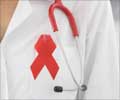HIV virus needs only days not weeks to neutralize immune system. That is a much faster pace than had been assumed thus far. Hence the window of opportunity for intervention too will stand reduced.
HIV virus needs only days not weeks to neutralize immune system. That is a much faster pace than had been assumed thus far. Hence the window of opportunity for intervention too will stand reduced.
Research into the earliest events occurring immediately upon infection with HIV-I shows t that the virus dealt a stunning blow to the immune system earlier than was previously understood, said Scientists at Duke University Medical Center.Appearing in the August issue of the Journal of Virology, the finding may make the challenge of designing an effective HIV/AIDS vaccine appear daunting. But researchers say the study has also yielded a blueprint for what a successful vaccine should look like, and moreover, when such a vaccine would need to work.
Until now, scientists believed that the window of opportunity to intervene in the process of HIV-1 infection lay in the three to four weeks between transmission and the development of an established pool of infected CD4 T cells. HIV-1 cripples the immune system by invading and killing CD4 T cells, key infection-fighters in the body.
"But this new study shows that HIV-I does a lot of damage to the immune system very early in that time frame, and now we feel that the opportunity to intervene most effectively may range from about five to seven days after infection," said Barton Haynes, M.D., the senior author of the study and director of the Center for HIV/AIDS Vaccine Immunology (CHAVI) at Duke University Medical Center.
Haynes said the findings suggest that an optimal vaccine strategy would have to pack a double punch: First, establishing as much immunity as possible before infection, much as classic vaccines do, and then following a few days later with a mechanism to provoke a strong, secondary, broad-based antibody response. "Vaccine candidates to date have pretty much followed a single strategy. Now we know that we need to activate multiple arms of the immune system and we have a better idea of when to do it."
The conclusion comes from the study of 30 people who were newly-infected with HIV-1. Plasma from these individuals was sampled every three days for several months – before, during, and after the "ramp-up" phase of infection, when HIV-1 is multiplying rapidly and heading toward its peak viral load. In measuring the levels of four products of CD4 T cell death during this period in these samples, they were able to track and establish a timetable of the virus's destructive path.
Advertisement
The researchers found that TRAIL levels increased significantly a full week (7.2. days) before peak viral load, which is approximately 17 days after HIV-1 transmission, suggesting that during the earliest period of infection, called the eclipse phase, TRAIL may actually initiate or hasten HIV-1's destruction of CD4 T cells. In contrast, they found that the levels of the other three cell death products were most significantly elevated during peak viral load.
Advertisement
Researchers also examined the effects of cell death products upon B cells, another arm of the immune system responsible for the creation of antibodies. Previous studies have shown that the antibody response to HIV-1 is "too little, too late" – appearing after the virus has peaked and after the reservoir of infected T cells has already been established.
Through a series of in vitro laboratory experiments with peripheral blood cells, scientists found that microparticles suppressed levels of IgG and IgA, two classes of antibodies that normally would protect a person against infection. "This is important because many scientists believe that a fast-acting memory B cell response as well as a T cell response will be necessary to fight HIV-1" said Nancy Gasper-Smith, the lead author of the study.
Daniel Douek, chief of the Human Immunology Section of the National Institutes of Health, said the study sheds new light on key events in the earliest phase of infection. "The cohort is a gem. It is clear from the raised levels of TRAIL that the body senses the virus before plasma viral loads have peaked. This suggests that the virus begins to cause damage in ways that may be unrelated to the well-described massive depletion of gut CD4 T cells that becomes apparent around peak viral load. For clinical practice, this means the window of opportunity in which antiviral therapies and vaccines must act is becoming ever narrower."
"These and other studies that recently revealed more about the singular nature of HIV-1 have given us valuable information that is helping us move closer to establishing a basic science foundation that can lead to novel technologies for vaccine design, Haynes said. Haynes. "It is becoming clearer why we have failed in our efforts to date, and what we need to confront to succeed in the future."
Source-Eurekalert
GPL













